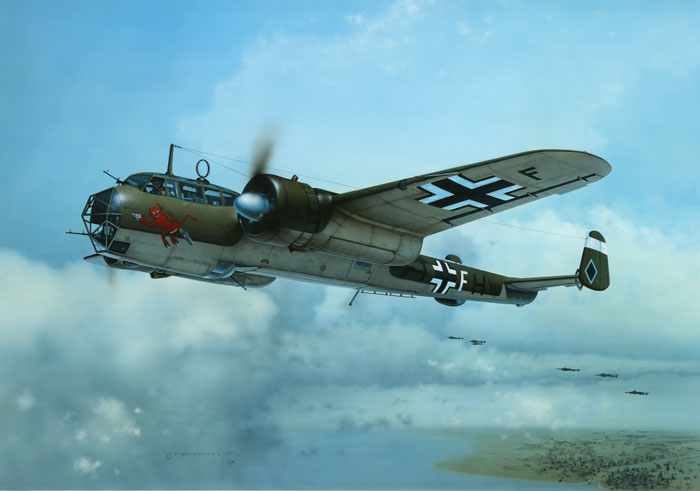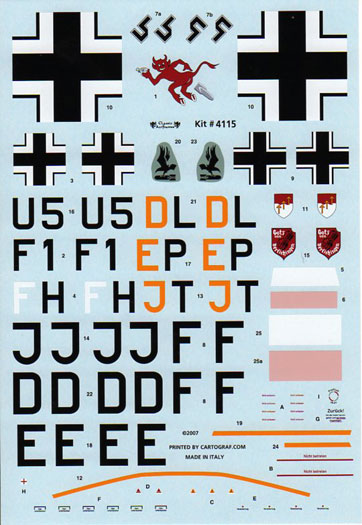|
Dornier Do
17 Z
the Flying Pencil in Luftwaffe Service

Classic
Airframes, 1/48 scale
S u m m a r y
|
|
Catalogue Number: |
4115 - Dornier Do 17 Z in Luftwaffe Service |
|
Scale: |
1/48 |
|
Contents and Media: |
104 parts in gray styrene, 19 parts in cream
colored resin, 9 clear injection molded
parts. Instructions, decal sheet and
painting guide for 4 aircraft. |
|
Price: |
MSRP USD$77.00 |
|
Review Type: |
FirstLook |
|
Advantages: |
Accurate in outline (and no banana-shaped
fuselage); useful options including detailed
bomb bay interior, two 250kg bombs and
positionable entry hatch; crisp engraved and
fine surface detail; high quality plastic
molding; thin, clear and separately packed
clear parts; impressively detailed resin
parts; four interesting marking choices. |
|
Disadvantages: |
Very clear but brittle clear parts. Absence
of DF loop. As usual, modeling experience is
always helpful. |
|
Recommendation: |
Highly
Recommended |
Reviewed by Steven
"Modeldad" Eisenman

Classic Airframes' 1/48 scale
Do 17 Z Luftwaffe Service will be
available online from Squadron
I am sure that a great number of
modelers have been awaiting the arrival of this kit.
Whether you are adding to your 1/48 scale Luftwaffe
bomber collection, or your Battle of Britain collection,
the Classic Airframes Do 17Z in Luftwaffe markings will
be a must have. No longer do you have to think for a
moment about the extensive plastic surgery needed to fix
the notorious Hobbycraft “Flying Banana”.
The contents of this kit do not
differ from the contents of the pervious boxing for the
Classic Airframes Do 17Z in Finnish Markings.
Brett Green did an excellent overview of the kit and a
partial build, which can be accessed through this link.
Brett went on to complete the build
and
the completed model can be accessed through this link.
Markings
It is the markings that modelers
will focus on, especially the box art marking. The
decals are well printed by Cartograph of Italy.

Click the thumbnails below
to view larger images:
Let’s discuss the box art first,
which has a fascinating history.
F1+FH: 1. / KG 76,
September, 1940. This aircraft was piloted by Oblt.
Robert Zehbe. This is the Do 17 that has become the
subject of a great and glamorous myth as a result of a
T.V. show.
Intending to bomb Buckingham
Palace, Zehbe’s aircraft was rammed at the last minute
by a Hawker Hurricane piloted by Sgt. Raymond Holmes.
Zehbe and Homes both floated to earth on parachutes and
Buckingham Palace was spared and the King and Queen
saved. “Long live the King!”
Now for the actual history. On 15
September 1940, Zehbe was on his way to bomb Central
London, approaching from the South-East, and then a
dog-leg west. On route he encountered engine trouble
and lagged behind the formation by about a half-mile.
The Hurricanes of 310 Squadron quickly jumped the
straggler, but failed to shot down Zehbe’s aircraft.
As Zehbe approached South London
his left engine was on fire. He was jumped by Hurricanes
of 609 Squadron and 504 Squadron. The effort to bring
Zehbe down was so intense that it seems 609 Squadron
complained that 504 Squadron was interfering in its
efforts.
Two of Zehbe’s crewman bailed out,
the gunner was dead. Zehebe’s aircraft was then
attacked by Holme’s Hurricane, and Zehbe bailed out.
Holme’s wing may have struck the Dornier at that point.
Holmes bailed out of the damaged Hurricane. The
Dornier, engulfed in flames, began to spin wildly out of
control. The outer wing panels broke off and the
fuselage broke in two. A good part of the aircraft came
down in Fulham, with other parts falling on Victoria
Station. It is believed that one of the bombs flung out
of the spinning aircraft, landed on the grounds of
Bucking ham Palace. Robert Zehbe died from his wounds
the next day.
Just like the actual aircraft, the
markings seem to have two different stories. The box
art appears to be based on a profile published in an old
Profile monograph, No. 164 The Dornier 17 & 215. While
the major markings are accurate (there is even an actual
photograph of the front of this aircraft), it is the
“tactical formation” marking which have recently come
under examination.
The “tactical formation” markings
were the allegedly white bands that appeared on the tail
fin and rudder and on the upper wing surface during
September 1940. The purpose of the marking was to
enable pilots flying in formation to quickly determine
the position of other aircraft in the formation.
Aircraft with the bar on the port (left) wing and port
fin meant that they were on the starboard (right) side
of the formation. Also the number of bars might have
indicated the Gruppe or Staffel status of the aircraft.
I use the phrase “allegedly white”
above quite intentionally. Based on the recent research
of Kenneth Merrick, which appears to be based on RAF
reports on downed aircraft, it appears that a number of
aircraft had the bars applied in various shades of
pink. Merrick surmises that red may have first been
tried, but was not distinguishable from a distance
against the 70/71 camouflage. The pale color might have
been found to provide for quicker identification.
Merrick indicates that the evidence
shows that Do 17Z F1+FH had a pale pink bar across the
fin and rudder on 15 September 1940. Merrick also
presents a picture of the fin and rudder of F1+FH as it
lay on top of Victoria Station. The picture, while
being black and white does not confirm the color, does
confirm the location of both the swastika and the bar.
The swastika is at mid-fin and appears to be centered on
the rudder hinge line. The bar is near the bottom,
extending from the leading edge to about half way across
the rudder.
Based on the fact that the bar is
on the port fin, the wing bar would be on the port
wing. The actual location of the wing-top bar is
conjecture as the wings were badly damaged, and the
reports seem to only indicate that the letter “F” was
outboard of the wing cross. But it is not clear whether
this was on top or underneath the wings. It is quite
possible that the bar covered the “F” outboard of the
cross on the port wing-top, although there is a picture
of another KG 76 aircraft with the bar inboard of the
cross.
Finally, it should be noted that
the bar appears to have been applied with a brush.
F1+JT: 9. / KG 76, circa
Fall 1940. The aircraft is in standard 70/71, but the
underside was covered in black distemper. The black
undersides were adopted when the Luftwaffe switched to
nighttime bombing after September 1940. The decals
provide for the individual aircraft number under the
wing should you decide to use the standard Farbton 65
underside.
U5+EP: 6. / KG 2, circa
1940. Simply 70/71/65.
U5+DL: 3. / KG 2, circa
1941. This aircraft in 70/71/64 carries the yellow
cowling and rudders that were the theatre markings for
aircraft in the Balkans. It carries the noseband
marking common to KG 2. The aircraft may or may not
have had the unit emblem. If it did, it may have been
on a yellow background for this particular aircraft as
it was a 3 Staffel aircraft.
This is a great kit. Having built
one, I can say that with a bit of care and effort it
builds into a great model of the Dornier Do 17Z flying
pencil. For me, I found that that it was better, and
easier, to leave the bomb bay open, as intended, rather
than closing it up. Care must be taken when fitting the
nacelles as, they are not handed, and use of putty is
required. Also, one should take great care in attaching
the clear parts to the nose.
There is one issue that will
require a bit of scratch building and careful work. If
one wants to build an accurate representation of Zehbe’s
F1+FH, one will need to remove the DF dome on the canopy
top and replace it with a DF loop. This will require
carefully sawing off the dome, filling in with plastic
stock and fashioning a DF loop.
I cannot verify which of the other
aircraft had the DF loop. It seems that the DF loop was
used on the Do 17Z-1 and was replaced by the covered
dome on the Z-2. However, Z-1s were often refitted with
the dome.
If you really want to get
obsessive, you can fashion gun travel limiting bars out
of fine wire for the two side machine guns. I did this
for my Finnish Do 17, and I liked the results. But be
very careful, as the clear part can crack easily.
Highly recommended from experience.
References
-
Luftwaffe Camouflage and Markings 1933-1945 Vol. One
and Two; K. A. Merrick; Classic Publications, 2005.
-
Dornier 17 in Focus; Chris Goss; Red Kite
Publishing, 2005
-
Dornier Do 17 The Yugoslav Story; Boris Ciglić &
Dragan Savić; Jeroplan Books, 2007
-
Kampfflieger Vol. One and Two; J. Richard Smith &
Eddie Creek; Classic Publications, 2004
A special
thanks to David Wadman.
Thanks to
Classic
Airframes for the review sample.
Classic Airframes kits are available worldwide through
hobby retailers and from
Squadron.com
Review and Images Copyright © 2007 by
Steven "Modeldad" Eisenman
Page Created 13 December, 2007
Last updated 01 January, 2008
Back to HyperScale Main Page
Back to Reviews Page
|
Home
| What's New |
Features |
Gallery |
Reviews |
Reference |
Forum |